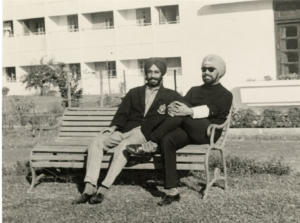K.P. Singh
Architect, Artist and Writer
A founding member and former president of The International Center, K.P. is still a tireless community advocate for the greater Indianapolis international community.
In 1967, K.P. Singh was at a crossroads. After graduating from the University of Michigan with a Master’s Degree in City Planning, Singh began his career in the United States at a Detroit-based urban design firm. But in the wake of the 12th Street Riot—one of the largest uprisings in the 20th Century—Singh found himself in need of a new job. That’s when K.P. Singh was interviewed by Michael A. Carroll at the Indianapolis Department of Metropolitan Development (DMD) about an opportunity in Indianapolis.
This was not Singh’s first experience with a fresh start. When he was a boy, his family fled from ethnic cleansing during the Partition of India in 1947, leaving their home in what is now Pakistan. But when he arrived in the U.S. to pursue his secondary degree, Singh had no intention of staying in the States after graduation.
K.P. Singh with His Brother, Gurbatap Singh
“I was on a student visa, and after graduation, my plan was to return back to India and start my career there,” said K.P. Singh. “But when I visited Indianapolis, I noticed people sitting and eating lunch outside along Monument Circle—laughing, talking and sharing their lives with one another just like in India. It was then I knew that Indiana would be my home.”
Despite his positive impression of Indianapolis, it was not an easy transition for Singh. He spent his first few weeks living at a YMCA because apartment owners refused to rent a unit to him. Even at lunch with his coworkers, restaurants would tell him to leave unless he took off his “hat,” referring to the turban he wore as part of his Sikh faith. K.P. Singh took this ignorance and racism as a challenge—to stay put and try to educate his Hoosier neighbors.
At the time, Indianapolis was also facing the challenges that come with a growing city. Singh watched as Indy outgrew its “No Place” nickname and Mayor Richard Lugar introduced the Unigov structure in the late 1960s. This change brought a considerable push to modernize the landscape of downtown Indianapolis, which would mean demolishing old buildings to build new parking lots—a change that architect K.P. Singh opposed.
In his words, “These buildings aren’t brick-and-mortar. They are characters that have life. They have stories that need to be preserved.” So, when Indianapolis Union Station was under threat of demolition, Singh drew an art piece to commemorate and celebrate the building’s life. The drawing immediately sold dozens of copies, and Singh’s unique, detailed ink style grew popular across the city.
K.P. Singh quickly became inundated with requests to draw other buildings throughout the city, state and nation. This marked another turning point in Singh’s career, as he eventually quit his job with the city to pursue art full-time in 1972.
Singh’s role in the Indianapolis community only grew when he was invited to attend the 500 Festival Breakfast with Mayor Lugar and take a lap around the track at the Indianapolis Motor Speedway. At first, he was puzzled as to why he was invited and contemplated not showing. But after the event, K.P. Singh realized that becoming a trusted partner in the community would help dismantle the discrimination he had faced.
“Each action showed me that we must come together to take Indianapolis in the right direction,” said Singh. “We needed a place for these ‘invisible immigrants.’”

The Center’s original location, 1050 West 42nd Street, artwork by K.P. Singh.
K.P. Singh continued to build a rapport with Mayor Lugar through other events like the Festival of Lights. He was then invited to the first planning meeting for The International Center in July 1972, which led to him becoming one of the founding board members shortly after. Now, more than 50 years later, K.P. Singh remains active in the community, serving on numerous boards and even receiving an honorary doctorate from Butler University in 2017.
“When I left India, my father told me one thing,” said Singh. “You are moving to a new country; you must show the best of yourself. Achieve this through service. Service is Love. Service is Emancipating. Service is Human.”
A writer, artist, educator, community leader and recipient of two Sagamore of the Wabash awards, K.P.’s legacy in Indianapolis is well and truly cemented.




